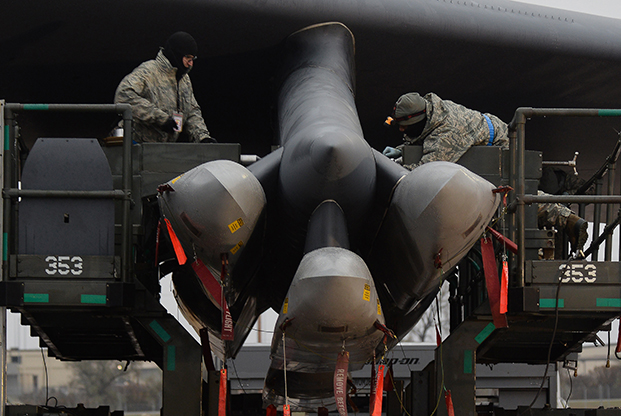
Airmen attach AGM-86B cruise missiles to a B-52H at Minot AFB, N.D., during a Global Thunder exercise in 2016. The proposed Long-Range Standoff weapon will enable the B-52H to remain an effective part of USAF’s nuclear bomber force. Photo: A1C J.T. Armstrong
The Long-Range Standoff weapon, or LRSO, is arguably the most controversial element of the Air Force’s strategic modernization plan. While there’s general—though frequently grudging—bipartisan congressional support for replacing most of the geriatric nuclear deterrence enterprise, there’s rather less enthusiasm for LRSO, a stealthy cruise missile that would be launched from B-52 bombers far outside enemy defenses or from B-21 stealth bombers that have penetrated enemy airspace.
The criticisms revolve around the weapon’s cost, whether it’s needed, and its potential to be “destabilizing.”
The Air Force has said relatively little about LRSO, explaining that it wants to keep adversaries guessing about its capabilities and technologies. Last summer, Lockheed Martin and Raytheon each received $900 million contracts to develop competing designs for the weapon, which will succeed the AGM-86 Air Launched Cruise Missile (ALCM) and, indirectly, the AGM-129 Advanced Cruise Missile (ACM).
_Read this story in our digital issue:
AND THE WINNER IS …
A winning design will be chosen in 2022, and after a development program, operational service is expected in 2030. Gen. Robin Rand, commander of Air Force Global Strike Command, told the Senate Armed Services Committee in June 2017 that the service had “dedicated $2.7 billion” to the program between Fiscal 2018 and 2022.
What is known about LRSO is that it will be extremely stealthy and presumably more accurate than the missiles it replaces. Industry and Air Force sources say it won’t be a hypersonic weapon, as that technology won’t be ready for operational use in time. An Air Force document circulated last summer referred to LRSO as having the designation “AGM-180/181,” a likely reference to the two competing designs, although it could refer to a possible nuclear/conventional split of production.
The Air Force is planning to build about 1,000 LRSOs, a portion would be for routine tests, but the bulk of which would be kept ready for combat use. The LRSO is expected to carry an upgraded version of the W80-4 nuclear warhead and be capable of operating in “a GPS-denied environment,” meaning it can navigate even if Global Positioning System signals are jammed. Rand said LRSO will “retain penetrating cruise missile capabilities through 2060,” suggesting it will be designed for a 30-year service life.
Service and industry officials have said LRSO will have a mission to destroy densely overlapped air defense systems, clearing a path for stealth bombers to penetrate enemy airspace.
The Congressional Budget Office, in a wide-ranging assessment of the cost to modernize the nation’s nuclear deterrence enterprise, released last fall, said that $28 billion in development, acquisition, and sustainment cost could be avoided over the next 30 years by terminating the LRSO program. The CBO noted, however, that this would only shave two percent off the overall nuclear modernization bill of more than $1.3 trillion over that same period. The actual acquisition cost for development and procurement of 1,000 missiles is estimated at about $10 billion.
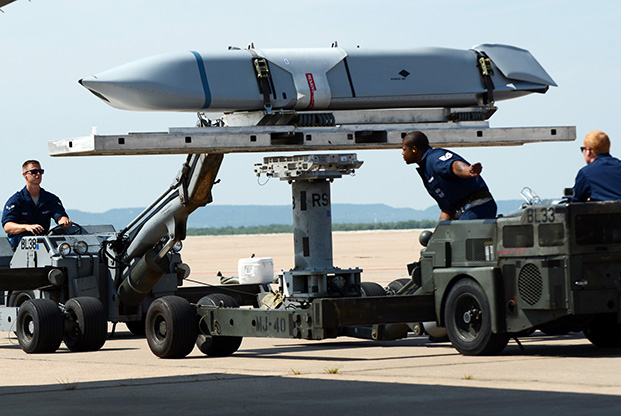
Airmen at Dyess AFB, Texas, load a JASSM cruise missile. USAF launched 19 JASSM during a recent air strike on Syria. Photo: SrA. Kedesha
LRSO DETRACTORS
The LRSO has some heavy-hitter critics. Former Defense Secretary William J. Perry—considered the “godfather” of stealth and precision-guided weapons at the Pentagon when he was its technology chief—co-penned an op-ed in the Washington Post in 2015, saying LRSO would be “destabilizing” to deterrence. He and co-author Andy Weber based this assertion on the fact that LRSO could be launched without warning, and an enemy would not know if it was a conventional or nuclear-armed weapon, compelling that enemy to treat the situation as “worst case” and respond with his own nuclear weapons.
Perry and Weber further argued that LRSO is redundant if the B-21 can penetrate enemy defenses and reach its intended targets through its stealth. They also said that if LRSO is meant to offer a President “flexibility” to use a low-yield weapon, such a purpose would be “dangerous” and “a grave mistake,” by lowering the threshold for use of nuclear weapons and greatly increasing the risk of escalation to all-out nuclear war.
Last year, nine Democratic senators introduced a bill that would cap LRSO funding until its need could be explained by the Trump administration’s Nuclear Posture Review. They echoed Perry’s arguments that LRSO is either unnecessary or destabilizing, or both. One of the senators, Dianne Feinstein (D-Calif.), had previously called for hearings on the need for the weapon.
Defense Secretary Jim Mattis, in answers prepared for his confirmation hearings in January 2017, voiced his support for modernizing the nuclear triad, but was—at that time—ambiguous about his support for LRSO. He promised he would “examine the utility and advisability of this … program within existing nuclear doctrine” and deliver firmer answers with the Nuclear Posture Review, promised within a year. The NPR was to be a DOD-driven holistic look at the nuclear deterrent enterprise, ranging from the scientific infrastructure of building and testing nuclear weapons to the viability of delivery systems across the services and the command and control architecture governing them.
“I’ve not yet completed my own review,” Mattis said at the time, adding, however, that LRSO as a weapon to eliminate air defenses helps deterrence strategy. “We have got to make certain the bombers can get through,” he asserted, “if they’re to be a valid deterrent.” Mattis further said he’d consult with Perry on the issue and was well aware of the “destabilizing” argument. Feinstein, in that same hearing, said LRSO has “features which concern me greatly,” but didn’t elaborate. However, “I’m not sure, for the cost, that we’ll end up with a practical deterrent,” she added.
Rand, in his testimony, said, “I cannot overemphasize this point: B-21 and B-52, without LRSO, greatly reduces our ability to hold adversaries at risk, increases risk to our aircraft and aircrew members, and negatively impacts our ability to execute the mission.”
Requirements for LRSO are set by US Strategic Command—not the Air Force—because it is a nuclear weapon. STRATCOM chief Gen. John E. Hyten, in a speech to the Hudson Institute in September 2017, said there are “a million reasons” for LRSO, most of which are classified and would be discussed in the Nuclear Posture Review. But he argued that the need to keep the B-52 in the nuclear game, coupled with the antiquity of the ALCM, means a new missile is necessary.
The ALCM, Hyten said, is “40-plus years old, … difficult to maintain, almost impossible to fly. We won’t be able to fly it much longer.” Without it, he said, “you don’t have the B-52 as a viable platform.”
Moreover, it’s a numbers game, Hyten said. A B-21 on a nuclear mission “only goes after one target. We need the ability to attack multiple targets with the air leg of our triad. That’s why you need a cruise missile.” Those arguments alone are “powerful enough” to make the case for LRSO, Hyten said, adding that “there’s a dozen other very powerful classified reasons that I’ve talked about with Congress.”
Gen. Stephen W. Wilson, the Air Force vice chief of staff and former Global Strike commander, calls LRSO a must-have capability. In an interview with Air Force Magazine, Wilson said “we’ve determined … all three legs of the triad make sense, that all three legs need to be modernized,” and the LRSO preserves part of that deterrent, given that ALCM was “designed to last for 10 years” and is “on its fifth life extension program.”
Asked if LRSO is needed to keep the new B-21 bomber relevant in 15 to 20 years, when air defenses may have developed the ability to detect it, Wilson answered indirectly. “We need to make sure we’ve got the capability to do both standoff and stand-in,” and prosecute both the nuclear and conventional mission, he said. As to the perishability of stealth, he said, “Yeah, disruptive technologies are out there. We’re constantly exploring what that means to us, what the threat’s doing, as well as what are we doing that’s changing the game, too.” However, “stealth is going to continue to be part of our programs going forward.”
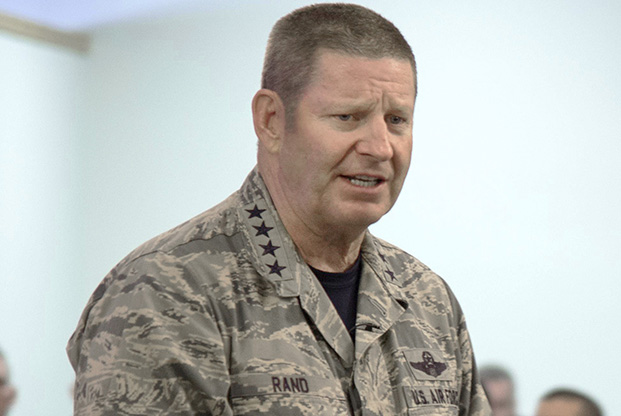
Air Force Global Strike Commander Gen. Robin Rand. Photo: SrA. Malcolm Mayfield
WE NEED IT
The Nuclear Posture Review, released in February, was unequivocal about the need for LRSO. The missile will “maintain into the future our bomber capability to deliver stand-off weapons that can penetrate and survive advanced integrated air defense systems, thus holding targets at risk anywhere on the Earth.” It specifically noted that Russia has developed new cruise missiles that expand its options for attack, and these steps need to be countered. The LRSO will preserve the efficacy of the bomber leg of the triad even if the B-21’s stealthiness is eventually overcome by adversary countermeasures, the NPR said. Also, LRSO “will enable the B-52H to remain an effective part of the nuclear-capable bomber force and preserve upload potential as a key hedge against unforeseen technical and geopolitical challenges.”
The NPR also noted that the US will develop a low-yield weapon to provide “more options” to the President, but said it will likely be delivered by a new missile, the Sea-Launched Cruise Missile, or SLCM, as well as a low-yield warhead that could be carried by the next Sea-Launched Ballistic Missile, or SLBM. A low-yield weapon, the NPR explained, “cannot substitute for [the LRSO] because LRSO is required to sustain an effective air leg of the Triad.”
The Nuclear Posture Review also said the US might forego developing SLCM if Russia agrees to “return to compliance” with its nuclear treaty obligations, reduces its “nonstrategic nuclear arsenal, and corrects its other destabilizing behaviors.”
In an April paper, “Sustaining the US Nuclear Deterrent: The LRSO and the GBSD,” authors from the Center for Security and Budgetary Assessments argued that LRSO is an essential element of nuclear modernization, and the cost, redundancy, and “destabilizing” arguments against it don’t hold water.
“There is little evidence that ALCMs were destabilizing during the Cold War,” CSBA authors Mark Gunzinger, Carl Rehberg, and Gillian Evans wrote. “In fact, bombers equipped with nuclear cruise missiles and gravity bombs may have been and remain the most [CSBA emphasis] stabilizing element of the US triad. Due to their visibility, ability to be recalled after launch, and longer flight times relative to ballistic missiles, bombers are considered particularly effective means for stabilizing crises.” Russia has pursued “dual-capable” conventional/nuclear missiles and does not seem “concerned with their potential to destabilize the nuclear balance.”
The LRSO would “complement” the penetrating bomber and not be redundant to it, the CSBA authors asserted, because the B-21 and B-2’s stealth capability “will eventually erode over their operational lives,” even if they are updated with fresher stealth technology. The ability to launch from outside enemy air defenses will preserve the bomber’s capability to deter, the authors maintained.
The Navy’s nuclear-armed Tomahawk Land Attack Missile, or TLAM-N, was retired in 2013 without a comparable replacement in hand, although conventionally armed Tomahawks remain in service and were used as recently as this April’s strikes against Syrian chemical weapons sites. The absence of a nuclear Tomahawk, however, has “reduced options available” for the US to “communicate its intent and resolve to its allies and potential adversaries in a crisis,” according to CSBA. The LRSO would “provide another extended deterrence option” for the US.
In addition to maintaining a retaliatory or first-strike capability in the bomber force, LRSO is a “cost-imposing” weapon, both Wilson and the CSBA authors have argued, compelling nuclear adversaries to beef up their defenses against it. Resources expended on air defense would therefore not be available for other offensive capabilities, either conventional or nuclear. A cost-imposing strategy has worked before: The Soviet Union dissolved soon after its military concluded that hundreds of billions of dollars’ worth of investment in air defenses had been rendered largely useless by the US Air Force’s stealth technology.
Wilson, in a May 2017 Air Force Association event, noted that a US bomber could carry 21 LRSOs,—“a very daunting challenge for any adversary,”—and would also be less costly as a deterrent than trying to develop a system to defend against comparable Russian weapons.
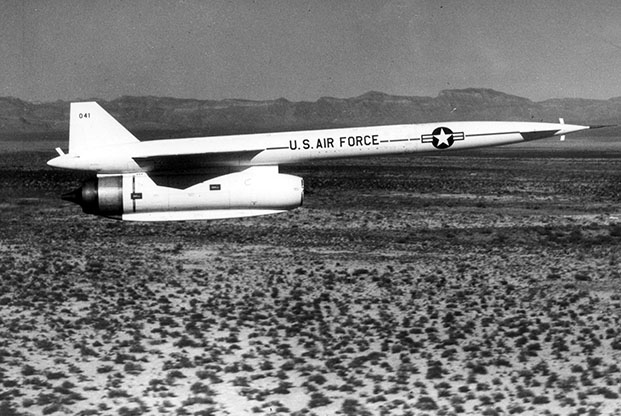
The Air Force has only fielded a few nuclear cruise missiles. One of them was the AGM-28 Hound Dog. Photo: North American Aviation/AFA Library
THE COST
The CSBA authors also noted the cost of LRSO is “a small fraction of the $94 billion the Pentagon has projected it will spend on the triad between FY 2016 and FY 2020.” The CSBA report pointed out that if LRSO is not pursued, and the ALCM retires without a replacement in hand, the US will “lose its ability to launch nuclear strike from standoff ranges” and hand Russia and China “the opportunity to gain significant advantages in the salvo competition,” potentially providing those countries a coercive advantage against the US.
The two LRSO competitors, Lockheed Martin and Raytheon, both worked on the AGM-129. Lockheed designed and built that missile—a stealthy successor to the ALCM. Only some 460 were ever produced, and the Air Force retired those between 2008 and 2012, saying they were too costly to maintain. The ACMs were physically destroyed, not converted into conventional weapons. The ALCMs they were initially intended to replace remain in service and are today over 30 years old.
The ACM retirement decision took place at a time of relative calm in US-Russian relations; Russia did not invade Ukraine until six years later.
While USAF has said in recent months that it wants to drastically shorten the development time lines of new projects, it’s not clear if the LRSO could benefit from program streamlining or whether the schedule has been hard-set. Wilson said USAF can’t afford any more 20-year development programs, due to the speed at which adversaries are fielding new capabilities. He said USAF is shooting to compress weapon development cycles to under five years, with a goal of three.
The matching $900 million LRSO contracts were for technology maturation and risk reduction, or “TMRR.” The Air Force’s top uniformed acquisition officer, Lt. Gen. Arnold W. Bunch Jr., acknowledged in October 2017 that LRSO funding in the TMRR phase would be somewhat higher than that for USAF’s new silo-based ICBM, the Ground Based Strategic Deterrent missile, or GBSD. The reason, he said, was to gain better reliability in the final product.
The Air Force wants to “ensure that we have a design that we can produce that will be reliable and available once it gets out into the field,” Bunch said. Experience with cruise missiles, he explained, showed that their reliability and availability “is not exactly what we need, so we took a different approach, put a lot more money into the [TMRR] phase, farther than we have before on these kinds of programs,” in the goal of obtaining better day-to-day performance.
“We’re calling it, ‘Design for Reliability and Manufacturing,’?” he added. Although combat performance is “critical,” the weapon isn’t worth much “if you can’t utilize it.”
The service later told Air Force Magazine through a spokeswoman that Bunch had based his comments on “a benchmark study … using historical data from two nuclear cruise missile programs and two conventional cruise missile programs.”
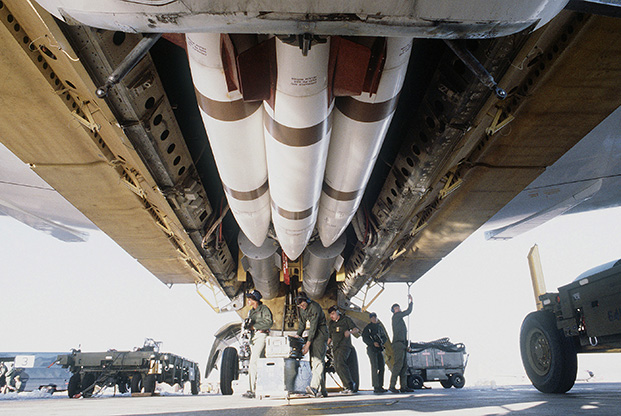
Three AGM-69 Short-Range Attack Missiles in the bomb bay of a B-52H at Ellsworth AFB, S.D., in 1984. Two Mark 28 thermonuclear bombs are mounted in front of the SRAMs. Photo: TSgt. Boyd Belcher via National Archives
PERFORMANCE, RELIABILITY
The goal for LRSO, she continued, is to have “the first missile produced from the production line to meet all reliability and operational requirements.” The Air Force wants to minimize design changes after the TMRR phase to lower “the risk of a future unaffordable reliability improvement program” and stick fast to the planned IOC date.
The spokeswoman would not identify the missiles in the study, but USAF has only ever fielded a few nuclear cruise missiles. They include the ALCM and ACM, the BGM-109G Ground-Launched Cruise Missile, or GLCM, the AGM-28 Hound Dog, the SM-62 Snark, and the AGM-69 Short-Range Attack Missile, or SRAM.
As for conventional cruise missiles, one likely to have been scrutinized in the study was the stealthy Northrop AGM-137 Tri-Service Standoff Attack Missile, or TSSAM. The highly secret TSSAM was beset by rapid schedule and cost growth, driven by launching the program before requirements were fully established and by frequent changes to requirements during development. Funding and management by committee among the services, who wanted air-, ship-, and ground-launched versions, further exacerbated its problems. It was terminated in 1994.
The following year, a replacement program, the Joint Air-to-Surface Standoff Missile (JASSM) program began. Lockheed Martin won the contract, and subsequently more than 3,000 AGM-158 JASSMs or JASSM-ERs (Extended Range) have been produced or are under contract. JASSM was used in combat in this spring’s strike against Syria. A variant, the Long-Range Anti-Ship Missile (LRASM) is in development for the Air Force and Navy.
In March of last year, Gen. Paul J. Selva, vice chairman of the Joint Chiefs of Staff, argued that LRSO is an “integral part” of the strategy for modernizing the strategic nuclear deterrent, noting particularly the “cost imposing” concept. Selva further argued that if there are members of Congress who are serious about getting rid of nuclear cruise missiles, the only way to negotiate them away is, paradoxically, to have one in the first place.
Where the US has had “success in negotiating types and classes of weapons out of adversary nuclear arsenals,” it’s been because “we possess a similar capability” that poses a severe defense problem for that adversary, Selva argued. To get rid of nuclear cruise missiles, “we should take that to the table” and “negotiate it in a bilateral, verifiable way so that we don’t give up the options and strategic leverage we have,” he said.